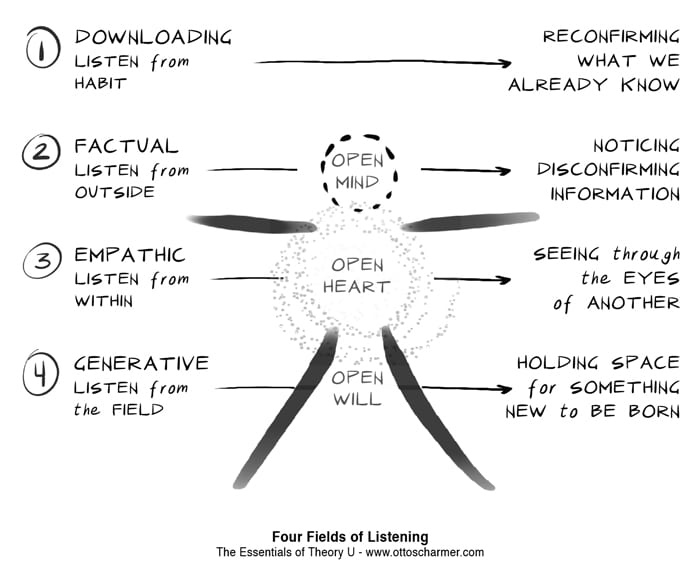Listening is one of the most critical skills in a work environment. Yet, not much effort is given to learning how to listen. In most cases, there’s simply a “discipline” approach, taught at school, by which people often learn how to fake attention, rather than listen to what other people say.
I don’t want to spend too much time on how to build this skill in generic terms. There’s abundant literature online full of practical tips and tricks worth looking at. I’m more interested in the development of this capability in the framework of an Organisation, up to the level of developing an overall listening strategy. Listening becomes a critical element of designing an organisation “for the whole self“, as a newly identified trend suggests.
The most basic and powerful way to connect to another person is to listen. Just listen. Perhaps the most important thing we ever give each other is our attention.
Rachel Naomi Remen, Culture of Empathy
Individual Listening
When we think at the personal level, Listening is composed of multiple “habits”, heavily influenced by different traits of personality. Sometimes it is not easy also to detach the ability to listen from the one of interpreting what we are Listening. Which is why I find many of the available models unsatisfactory.
Otto Scharmer’s 4 Levels of Listening is a simple model that can support leadership development and allows gaining a greater understanding of interactions between individuals within an organisation.
Some have added a “Level 0” or Cosmetic Listening which really would be the baseline of the model. This is what we’re doing when someone asks, “Are you even listening?” and your brain can repeat back the last 3-7 words the person said. Some part of your brain is collecting words, but not their meaning. It’s pretend listening, and it doesn’t get you far. Let’s see the other levels a bit more in detail.

Level 1: Downloading
This is the most basic and permanent form of listening. It is straightforward, and usually only occurs when the individual is familiar with what they are hearing/being told, and are therefore only looking to confirm what they already know, or their current opinion, which is likely not to change.
Everything they are hearing is being projected onto preconceptions of the situation and is reflecting the past rather than the present moment. It’s almost like a filter is always on at this level.
Level 2: Factual Listening
This is the next stage, which involves listening with an entirely open mind and without any presumptions or prior judgements. Individuals employing factual Listening are attentive to new ideas and data and are accepting of any differences from what they already know.
The outcome is that their opinions or views on a situation may be altered by new information which is now available to them. This is good for anybody in an analytics situation but is still not sufficient for those who need to be more visionary, such as leaders.
Level 3: Empathic Listening
Empathic Listening requires a yet more profound level of listening and needs the individual at hand to have a certain level of emotional intelligence. This is the ability to truly connect with the individual who is being listened and to see the world, situation, subject or opinion as they do, through their eyes, and provides them with an emotional connection to the speaker.
This provides the listener with alternative perspectives which can help to sculpt and define their decision-making.
Level 4: Generative Listening
This is the highest, most informative level of listening, and is an essential skill for leaders to learn. It requires the individual to gain a connection with the best future that they can; an emerging and developing future, or possible futures.
This subsequently results in a profound shift and a profound sense of knowing. This can be used to envisage individual development, and can also be used to design and plan organisational change.
Building Advanced Listening
A research done in 2016 and published in HBR, showed that adults typically overestimate their listening capabilities. The research, however, pointed out that great listening skills go beyond keeping silent, nodding and repeating back what the talker said. Their conclusions outline 4 facts about Listening that are relevant in our discussion:
- Good listening is much more than being silent while the other person talks. To the contrary, people perceive the best listeners to be those who periodically ask questions that promote discovery and insight. Good listening is consistently seen as a two-way dialogue, rather than a one-way “speaker versus hearer” interaction. The value of Listening lies in the conversation that is created.
- Good listening included interactions that build a person’s self-esteem. The best listeners made the conversation a positive experience for the other party, which doesn’t happen when the listener is passive or too critical. Good listeners make the other person feel supported and convey confidence in them. Building a Safe Environment becomes a critical element to enable positive listening.
- Good listening was seen as a cooperative conversation. Feedback flows smoothly in both directions with neither party becoming defensive about comments the other makes. Poor listeners are instead seen as competitive, always trying to find the “error” or “flaw” in the talker effort. Good listeners may challenge assumptions and disagree, but the person being listened to feels the listener is trying to help, not wanting to win an argument.
- Good listeners tended to make suggestions. Good listening invariably included some feedback provided in a way others would accept and that opened up alternative paths to consider. It’s not about jumping into conclusions but is about moving the collaborative conversation to a shared goal.
Again, a way to illustrate how Listening can really build value through the conversation it creates, becoming an enabler for Learning, Curiosity, Creativity and Decision-Making.
How can I stimulate Listening in Others?
For what we mentioned just above, Listening is not a skill that is easily “taught” to others, especially because so many of us simply know how to fake the moment of listening (thank you educational system!).
For a leader, therefore, it becomes precious to show others how you listen. Something that can be enormously difficult, especially when people you communicate with barely reach your level of attention. Our usual model can come to help:
- Model it. Make space for listening, giving time and attention to your team members, ensuring you withhold judgement when listening. Take your time before answering, as the reflection time will provide a clear impression to the speaker that you have listened.
- Enable it. Use clarifying questions wherever possible. This will allow you not to assume anything, and also ensure that others perceive a genuine interest in what they have said. When in a team meeting, facilitate the listening behaviour by asking another member of the team to summarise, as this will guide the overall group to be more attentive.
- Celebrate it: Way too often team dynamics reward people who speak rather than those who listen. Try to make room of appreciation for this skill, for example, by noticing who has successfully gathered multiple sources of information, paying attention to different contributors.
Can we design organisations for Listening?
So far, I’d never really thought of bringing the though of listening into a concept of intentional design. However, the article just published by Naomi Stanford on designing a listening organisation has opened my eyes, particularly as she cites the report Creating An ‘Architecture Of Listening’ In Organisations by professor Jim Macnamara.
there is little focus on organizational listening […]
Jim Macnamara, Creating An ‘Architecture Of Listening’ In Organizations.
Organizations […] have thousands, hundreds of thousands, or even millions of stakeholders – whether these are citizens, customers, shareholders, employees, members, patients, or ‘consumers’ generally. Therefore, organizations need to be capable of large-scale listening.
And the data appear to confirm this. The same Jim Macnamara states that on average, 80 per cent of the so-called communication resources of public and private sector organisations are deployed to disseminate their messages. Sometimes, up to 95 per cent of the communication resources of organisations are devoted to speaking. Not Listening. Which results in most organisations who “listen sporadically at best, often poorly, and sometimes not at all.”
The report goes on, and states that “effective organisational listening requires an architecture of listening, designed into an organisation and be deployed in a coherent, complementary way, comprising eight key elements”:
- A Culture of listening;
- Policies for listening;
- Addressing the politics of listening;
- Structures and processes for listening;
- Technologies for listening;
- Resources for listening;
- Skills for listening;
- Articulation of listening to decision-making and policymaking
Not an easy task, but a key and essential element in a genuinely effective organisational design that is based on Design Thinking principles of Human Centric design.
Let’s check this up
Let’s do a pulse check on how you are personally doing on Listening. Think about the last week at work or at home, how many of the following statements are true?
- I did take time to reflect before intervening in a dialogue with my remarks.
- I did pose some reframing questions before giving my opinion.
- At the end of a meeting, I summarised what was said by the different members.
- I did listen with “open heart” to a point of view, even though I did not agree with it.
- I matched my team’s member points of view, and have generated a new overall approach as a result of a discussion.
And you? What do you think of the need to improve Listening?

What Skills for the Future of Work?
This post is part of a series of articles on Skills and Competencies required to succeed in the Future of Work. Read the main article, and access all the other available posts.
Photo by Cristina Gottardi on Unsplash

[…] Building on the concept of Diversity of wisdom means moving away from purely looking at the external, “physical” aspects of Diversity. Often these aspects can influence a lot the Diversity of points of view, but there’s not a mathematical correspondence between the two elements. This is also one of the reasons why Critical Dissent needs to be built as a critical skill in the organisation. This, unfortunately, goes often against our innate desire to respect hierarchies. We need to ensure this aspect is built in the way we manage our teams if we want to profit from true enriching Diversity (which also means that we need to continue enriching our Listening Skills). […]
[…] do and that you do well, Matching your Passion to the people whom most want it and Listen very carefully to the feedback of your […]
[…] workshops imply the usage all of the competencies we have identified for the Future of Work: Listening, Curiosity, Authenticity, Learning Agility, Decision […]
[…] awareness, attention and consciousness. We have already mentioned this model as I spoke about Listening, as I referred to it as not just an individual skill, but rather as a capability to be developed […]
[…] I just want to single out a few key aspects: having goals, receiving feedback (which is why Candor becomes such an important skill), gratitude and strong Listening. […]